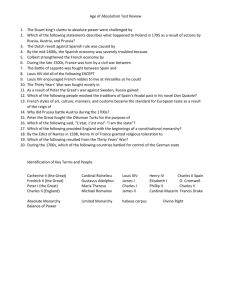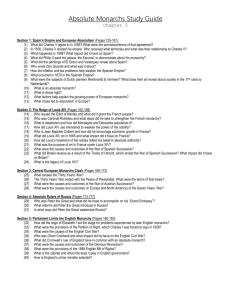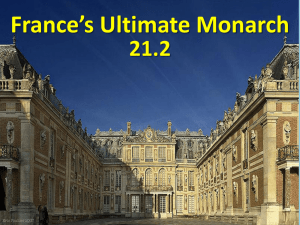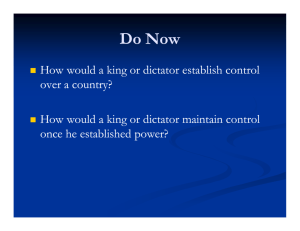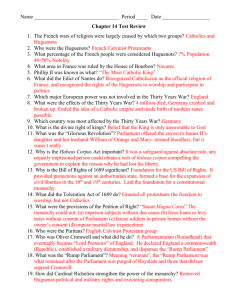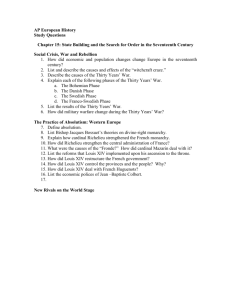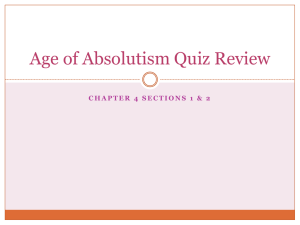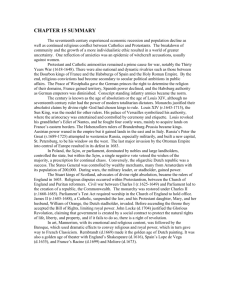Chapter 13 European State Consolidation in the 17th and 18th
advertisement
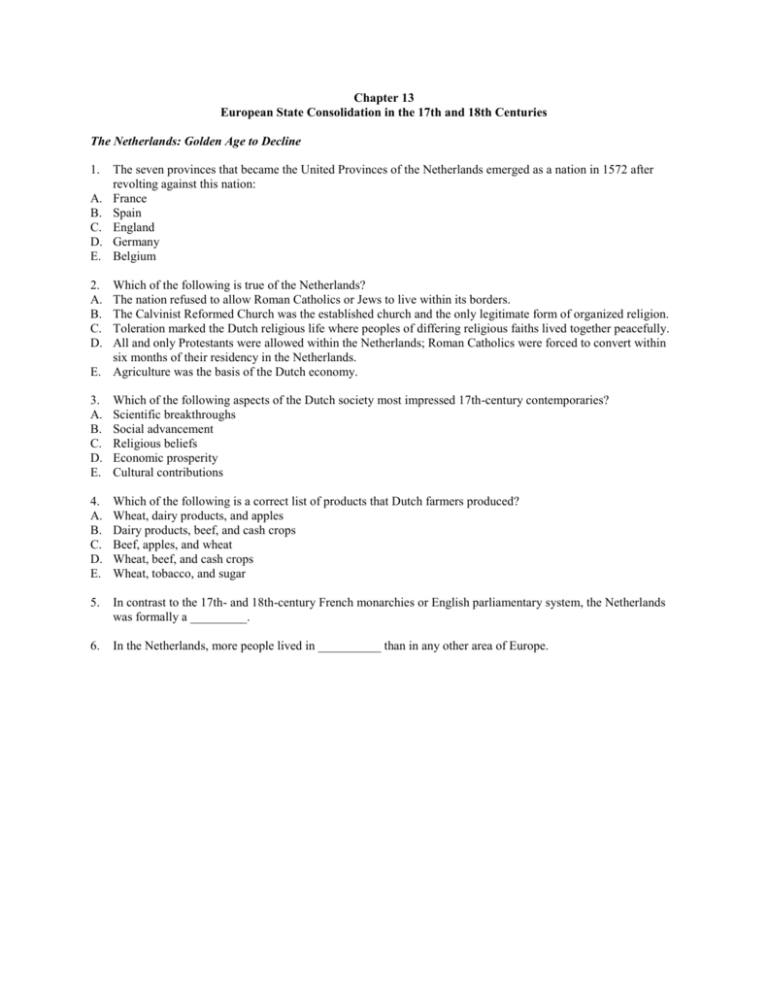
Chapter 13 European State Consolidation in the 17th and 18th Centuries The Netherlands: Golden Age to Decline 1. A. B. C. D. E. The seven provinces that became the United Provinces of the Netherlands emerged as a nation in 1572 after revolting against this nation: France Spain England Germany Belgium 2. A. B. C. D. Which of the following is true of the Netherlands? The nation refused to allow Roman Catholics or Jews to live within its borders. The Calvinist Reformed Church was the established church and the only legitimate form of organized religion. Toleration marked the Dutch religious life where peoples of differing religious faiths lived together peacefully. All and only Protestants were allowed within the Netherlands; Roman Catholics were forced to convert within six months of their residency in the Netherlands. E. Agriculture was the basis of the Dutch economy. 3. A. B. C. D. E. Which of the following aspects of the Dutch society most impressed 17th-century contemporaries? Scientific breakthroughs Social advancement Religious beliefs Economic prosperity Cultural contributions 4. A. B. C. D. E. Which of the following is a correct list of products that Dutch farmers produced? Wheat, dairy products, and apples Dairy products, beef, and cash crops Beef, apples, and wheat Wheat, beef, and cash crops Wheat, tobacco, and sugar 5. In contrast to the 17th- and 18th-century French monarchies or English parliamentary system, the Netherlands was formally a _________. 6. In the Netherlands, more people lived in __________ than in any other area of Europe. Two Models of European Political Development 7. A. B. C. D. E. What were the two most important models of European political development in the early modern period? Military despotism and democratic socialism Democratic socialism and parliamentary monarchy Monarchy and socialism Parliamentary monarchy and political absolutism Democracy and authoritarianism 8. A. B. C. D. E. Changes in military structure and technologies: favored absolute monarchies. increased the costs of war, which weakened monarchies across Europe. cut the costs of war. increased the costs of war, and governments across Europe found different ways to adapt. forced monarchs to abandon expansionist policies. 9. Success in building a secure financial base independent of the support of noble estates, diets, or assemblies is indicative of ________ rule. Constitutional Crisis and Settlement in Stuart England 10. A. B. C. D. E. All of the following are true of James I EXCEPT: he was openly Catholic. he was the son of Mary Stuart. he inherited a large royal debt and a fiercely divided church. he succeeded the childless Elizabeth I of England. he was a strong believer in the divine right of kings. 11. A. B. C. D. E. During the reign of James I, the British Parliament met: annually. continuously. only when convened by the monarch. twice a year. when called into session by the Speaker. 12. All of the following roused suspicion of James’ foreign policy EXCEPT: A. B. C. D. E. he concluded peace with Spain in 1604. his attempt to relax penal codes against Catholics. his declaration of war against Spain shortly before his death. his hesitation to rush English troops to aid the Germans at the outbreak of the Thirty Years’ War. his efforts to arrange a marriage between his son and a Spanish princess. 13. A. B. C. D. E. Charles I did all of the following to raise money EXCEPT: levy new tariffs and duties. force Parliament to grant him the funds he needed. attempt to collect discontinued taxes. subject English property owners to a forced loan. enforce previously neglected laws. 14. A. B. C. D. The Petition of Right required all of the following EXCEPT: troops not be billeted in private homes. no freeman should be imprisoned without due cause. no forced loans without the consent of Parliament could be imposed. Parliament would meet and confer at least every six months, regardless of whether it was summoned by the monarch. E. no taxation without the consent of Parliament could be imposed. 15. A. B. C. D. E. Charles I might have ruled indefinitely without Parliament had his religious policies not provoked war with: France. Ireland. Spain. Scotland. the Netherlands. 16. A. B. C. D. E. Under Oliver Cromwell, England was officially: a Puritan republic. a Catholic monarchy. an Anglican republic. a Quaker republic. a Protestant democracy. 17. After Cromwell died in 1658, the English were ready by 1660 to restore: A. B. C. D. E. the monarchy and the Anglican Church. the Presbyterian Church and diplomatic relations with Spain. the monarchy and diplomatic relations with Spain. diplomatic relations with Spain and the Anglican Church. voting rights to Catholic males. 18. In the Treaty of Dover, Charles II and Louis XIV’s secret agreement called for Charles II to: A. dismiss the Parliament of Lords and Commons, and in exchange Louis XIV would revoke the Edict of Nantes. B. announce his conversion to Catholicism, and in exchange Louis XIV promised to pay Charles a substantial subsidy. C. revoke the Clarendon Code, and in exchange Louis XIV promised to pay Charles a substantial subsidy. D. revoke the Test Act, and in exchange Louis XIV would revoke the Edict of Nantes. E. declare war on Spain. 19. A. B. C. D. E. This king issued the first Declaration of Indulgence in 1672: Charles I Charles II James I George I James II 20. A. B. C. D. E. Which of the following events completed the Glorious Revolution? Charles I was executed. William and Mary were proclaimed English monarchs. George II became king of Great Britain. The Secret Treaty of Dover was signed between England and France. James II was executed. 21. A. B. C. D. E. Robert Walpole (1676–1745) derived his political power from all of the following EXCEPT: the support of King George I. his leadership abilities in the House of Commons. his control of government patronage. his ability to maintain peace abroad. his collaboration with leading Catholics. 22. When James II became king, he immediately demanded the repeal of the _________. 23. Refer to the excerpt “King James I Defends Popular Recreation Against the Puritans.” What advantages did James I see in regular exercise? What did James list as a prerequisite for enjoying sporting activities on Sunday? Who was excluded? Why? Explain. . 24. Refer to the passage “Encountering the Past: Early Controversy over Tobacco and Smoking.” What were James’ specific objections to tobacco? Do you think he was ahead of his time in his stance on tobacco? In present-day society “sin taxes” still thrive. Identify at least three industries in which the government imposes sin taxes today. Do you agree or disagree with this type of legislation? Explain. Rise of Absolute Monarchy in France: The World of Louis XIV 25. A. B. C. D. E. According to advocates of the “divine right of kings,” kings could only be judged by: God. the nobility. the people. fellow kings. the Pope. 26. A. B. C. D. E. The revocation of the Edict of Nantes resulted in all of the following EXCEPT: the closing of Protestant churches and schools. the exile of Protestant ministers. the ceremonial baptism of Protestant children by Catholic priests. the sentencing of nonconverting laity to the galleys. the execution of a majority of the Protestant nobility. 27. A. B. C. D. E. John Law believed that: halt of gold payments in France was absolutely necessary. France should abandon its overseas colonies. France should dramatically increase its level of taxation. the government that governed least governed best. an increase in the paper-money supply would stimulate France’s economic recovery. 28. A. B. C. D. E. The chief feature of 18th-century French political life was the: lack of leadership on behalf of Louis XIV. failure of the nobility to dominate the Parliament. protest by the peasantry to gain more influence and representation in Parliament. attempt of the nobility to use its authority to limit the power of the monarchy. absence of sustained periods of warfare. 29. King Louis XIV won the support of the French ________ by supporting their local influence and social status. 30. The palace at ________ is a perfect example of how Louis XIV used the physical setting of his court to exert political control. 31. Louis XIV’s power and central position in French society were reflected in the unofficial title “The ________.” 32. A Roman Catholic religious movement known as ____________ arose in the 1630s in opposition to the theology and the political influence of the Jesuits and adhered to the teachings of St. Augustine. Central and Eastern Europe 33. A. B. C. D. E. Which of the following dynasties is correctly identified with the region it ruled? Hohenzollern dynasty in Prussia Habsburg dynasty in Russia Romanov dynasty in Austria Sejm dynasty in Poland Havel dynasty in Bohemia 34. A. B. C. D. E. Which of the following was NOT true of 17th- and 18th-century Poland? The Polish monarchy was elective. Most of the Polish monarchs were foreigners and the tools of foreign powers. The Polish nobles had a central legislative body called the Sejm, or diet. Polish nobles excluded merchants and town leaders from power. All things considered, Poland’s government was remarkably effective. 35. A. B. C. D. E. Which of the following was NOT a part of the Austrian Habsburg Empire in the 18th century? Bohemia Silesia Galicia Croatia Brandenburg 36. A. B. C. D. E. He was known as the Great Elector: Frederick William John III Sobieski Michael Romanov Theodore II Peter the Great 37. The ________ was meant to ensure that Maria Theresa could inherit the Habsburg crown. 38. Under Hohenzollern rule, ________ were allowed almost complete control over the serfs on their estates. 39. Refer to the excerpt “The Great Elector Welcomes Protestant Refugees from France.” Why do you believe the elector of Brandenburg welcomed the French Protestants? What did the elector do to encourage immigration? Do you think this policy was more beneficial for those immigrating or to the Hohenzollern dynasty? Why? Russia Enters the European Political Arena 40. A. B. C. D. E. The reign of Ivan IV was immediately followed by the: reign of the five good tsars. reign of Peter the Great. purging of the boyars. rise of the plutocrats. “Time of Troubles.” 41. A. B. C. D. E. Under the rule of Peter the Great, Russia’s boyars: gained power. became the primary agents of modernization. lost much of their power. were exiled to Siberia. launched two devastating insurrections. 42. Russian victory in the Great Northern War led to: A. the decline of Poland. B. a permanent Russian influence on European affairs. C. an alliance with England D. an alliance with Finland. E. the decline of Estonia. 43. A. B. C. D. E. Under the Peace of Nystad in 1721, Russia gained control of: Estonia, Livonia, and part of Finland. Livonia, Latvia, and Finland. Estonia, Latvia, and part of Finland. Livonia, Sweden, and part of Finland. Finland, Sweden, and Latvia. 44. A. B. C. D. E. St. Petersburg: was built on the Gulf of Sweden. exemplified Russia’s new orientation to the West. was completed in 1709 but not inhabited until Russia defeated Sweden. was given that name by Lenin after the 1917 Russian Revolution. had been an important city for centuries when Peter the Great made it his capital. 45. A. B. C. D. E. The “Table of Ranks,” published by Peter the Great in 1722, was: a table that equated a person’s social position with his rank in the bureaucracy or the military. a table that equated a person’s social position with his lineage among the traditional landed nobility. a table that equated a person’s social position with his annual income. Russia’s first income tax. an outline of Peter’s estimation of the relative power of European nations. 46. The ________ dynasty ruled Russia from 1613 to 1917. 47. The dangers and turmoil of Peter the Great’s youth convinced him that the power of the tsar must be made secure from the jealousy of the ________. 48. Refer to the passage “Peter the Great Tells His Son to Acquire Military Skills.” Does Peter feel that a ruler should go to war frequently and lightly? Does Peter’s advice sound like typical parental advice? Does Peter try to limit what Aleksei may learn outside of military strategies and combat? The Ottoman Empire 49. A. B. C. D. E. Over the years, Dhimmis in the Ottoman Empire obtained economic success because: they used their military service and skills for financial gain. they possessed the highest level of commercial skills in the empire. they established poll taxes for non-Muslims in the empire. their rise in political service through the empire reaped a financial gain. they were willing to deal directly with non-Muslims. 50. A. B. C. D. E. The Ottoman sultans ruled their empire through administrative units called: ullama. satraps. caliphates. jannisary. Millets. 51. A. B. C. D. E. The Treaty of Carlowitz required the Ottoman Empire to: lose Constantinople and thus its access to the Black Sea. surrender the heart of its empire in Europe. relinquish its control of the Sinai Peninsula. forfeit all coastline to the Persian Gulf. adopt Christianity as the official state religion. 52. The Ottoman Empire was the largest and most stable political entity to arise in or near Europe following the collapse of the ______________. 53. In 1571, the Ottomans suffered a major naval defeat at the battle of _____________. 54. Through the practice known as the _____________, the Ottomans, until the end of the 17th century, recruited their most elite troops from Christian communities usually in the Balkans.

